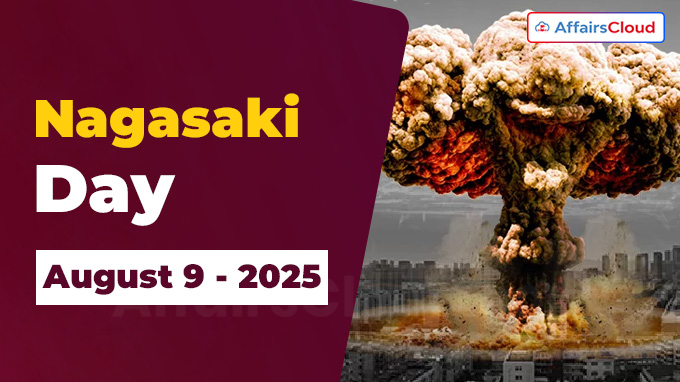
Nagasaki Day is annually observed across the globe on 9 August to commemorate the atomic bombing of the Japanese city of Nagasaki by the United States of America (USA) in 1945, during World War II (WWII – 1939-1945).
- 9 August 2025 marks the 80th anniversary of the atomic bombing of Nagasaki.
Exam Hints:
- Event: Nagasaki Day 2025
- Date of Observance: 9th August (annually)
- Edition: 80th
- Significance: Remembrance of the 1945 atomic bombing victims during World War – II
2025 Events: Nagasaki Peace Memorial Ceremony(Japan), UN -Exhibition for Peace.
Background:
Inaugural Ceremony: The 1st Nagasaki Day ceremony was held on 9th August 1947, organised by the Government of Japan to promote lasting peace and memorial of the Nagasaki victims of the 1945 atomic bombing.
Memorial Park: Every year on 9th August, the Memorial Service is held at the Peace Statue Plaza, Nagasaki Peace Park, Nagasaki, Japan, to mark the anniversary of the atomic bombing.
- The Memorial Park holds a 10-meter(m)-tall bronze Peace Statue to commemorate the victims of the atomic bombing and to promote global peace.
About Nagasaki Atomic Bombings:
Overview: On 9 August 1945, the United States Army Air Forces (USAAF) Boeing-29 (B-29) airplane named “Bockscar“ dropped the 2nd atomic bomb, Fat Man, over Nagasaki.
- The bomb was dropped from 29,000 feet and exploded at 1,650 feet above the slopes of the city.
Prequel Attack: On 6th August 1945, the 1st atomic bomb, “Little Boy”, was dropped over Hiroshima (Japan), three days before the Nagasaki attack.
About Fat Man: It was a Plutonium, implosion-type bomb with a force of 21,000 tons of Trinitrotoluene (TNT). It weighed over 10,800 pounds (approximately 4,670 kilograms, kg) and measured 10.8 feet in length and 60 inches in diameter.
- The B-29 bomber was piloted by the USAAF Major Charles Sweeney. The co-pilot was Captain Charles Donald Albury.
Primary Target: The USAAF’s initial primary target was Kokura Arsenal, a massive collection of war industries adjacent to the city of Kokura.
- Due to visibility issues caused by the clouds and smoke over the primary target, and anti-aircraft gunfire at Kokura, the bomber was diverted to its secondary target, Nagasaki, a port city.
Note: Little Boy and Fat Man were 2 different types of atomic bombs developed by the Manhattan Project, the USA government research project during WWII to build the 1st atomic bomb.
Aftermath: The bomb destroyed 3 square miles of the city and caused about 140,000 deaths by the end of 1945.
- The “hibakusha” are the surviving victims of the atomic bombs which fell on Hiroshima and Nagasaki.
2025 Events:
UN – Exhibition for Peace: From July 11 to August 17 2025, the United Nations University (UNU) hosted an exhibition titled “Exhibition for Peace: 80 Years Since the Hiroshima–Nagasaki Atomic Bombings” at the UNU Headquarters in Tokyo(Japan).
- It features a collection of photographs and historical information at the Virtual Reality(VR) corner, to experience the devastation of the nuclear attacks and the environmental transformation after the bombing.
Purpose: To raise awareness and provide insight into current nuclear disarmament efforts and global peace movements.
About First Nuclear Explosion:
Detonation : It occurred on 16 July 1945 when a plutonium implosion device was tested at a site located 210 miles south of Los Alamos, New Mexico, the USA.
- It was on the plains of the Alamogordo Bombing Range, known as the Jornada del Muerto. The code name for the test was “Trinity.”
About the Gadget : It is an implosion-type plutonium bomb named “The Gadget”.
Significance: It was the world’s first-ever atomic device detonation that occurred in the New Mexico desert during the Trinity test.
About United Nations University(UNU):
Chief Academic and Administrative Officer(Rector)- Tshilidzi Marwala
Headquarters- Tokyo, Japan
Established- 1973




